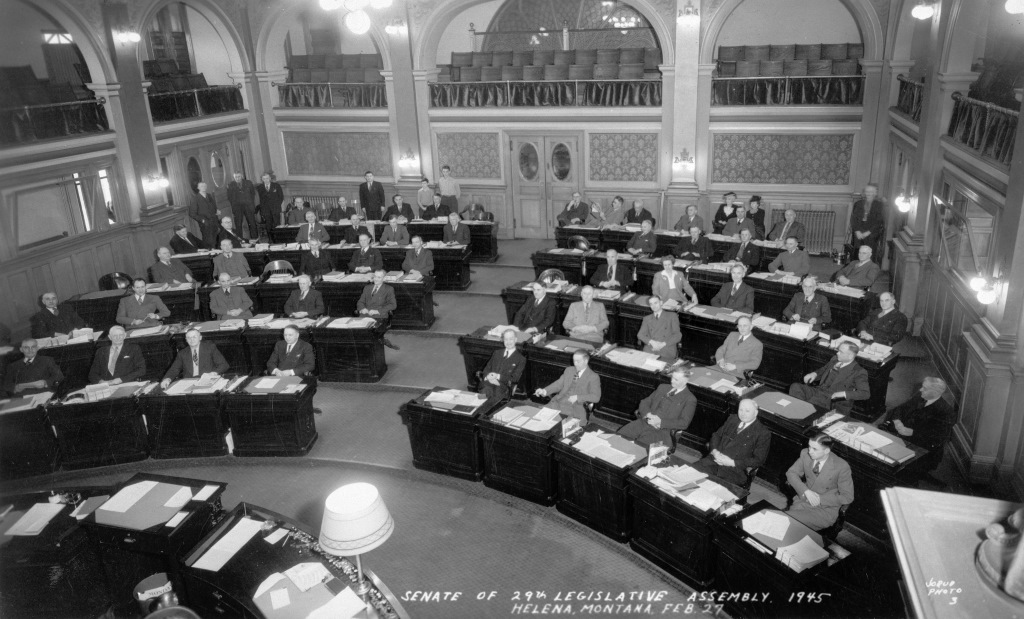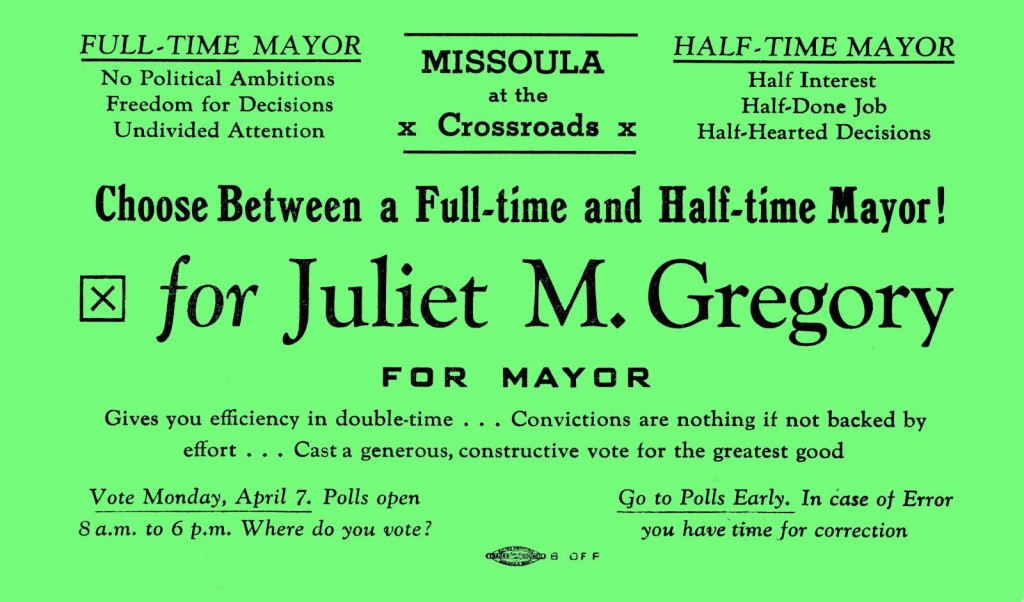
According to one common narrative, the post-World War II period marked a “return” to traditional gender roles, including breadwinner husbands and homemaker wives. But contrary to this stereotype, in the 1940s and 1950s married women entered the paid workforce in greater numbers than ever before. Women also volunteered with community organizations and were actively involved in both political parties. In Montana, a small but significant number of women even ventured into—and achieved success in—the traditionally masculine world of electoral politics. These postwar politicians achieved a number of important “firsts” and gained political experience that would be invaluable in the push for equal rights in the 1960s and 1970s.
Among these postwar women politicians was Ellenore Bridenstine of Terry, who in 1945 became the first woman elected to the state senate. An active participant in the local Republican Party and the wife of the only physician in Prairie County, Bridenstine recalled her decision to run for office: “Many of my women friends felt that I was crazy to try for it. But I decided to try for it anyway just to see what would happen. The man holding the office had never campaigned, and I am sure that he felt he would not need to against a woman.” Bridenstine won her seat by a mere six votes but was reelected in the next cycle.

In the late 1940s and 1950s several other women won seats in the Montana legislature. Some, like Republican Bertha Streeter of Lake County, elected in 1957, came to the state senate after holding local office. Many others served multiple terms. The number of women active—and successful—in local and state politics suggests that Montanans supported women’s political ambitions with their votes. Historian Joanne Meyerowitz has found widespread admiration during the 1950s for “women who exhibited ‘devotion to the public good.’” The success of Montana’s postwar politicians fit this emphasis on female service.
Once elected, Montana’s women politicians were expected to live up to the conservative stereotypes of wife and mother while they worked to better their communities, and their experiences reflect differential treatment based on their gender. Bridenstine “felt really sorry for some of [her] fellow senators, because they did not know how to handle working with a woman. . . . Some of them were too polite, jumping to their feet whenever I approached them for advice, while some of them simply ignored me.” Antoinette (“Toni”) Fraser Rosell, a Billings Republican who was elected to the House in 1956 and who remained active in the legislature for the next two decades, recalled that she was treated “fairly” by her colleagues—although she ate sack lunches because she “was not invited out to lunch by lobbyists.”
In general, female politicians worked within cultural stereotypes about women’s political capacities. During the Progressive Era, American women had carved out distinct niches in politics based on the belief that women were naturally suited to deal with certain social issues like education, maternal and child welfare, and public health. This “female dominion” of American politics, as historian Robyn Muncy has pointed out, was a place where women could exercise significant political power even as their authority was circumscribed by more powerful male politicians and bureaucrats.
The work of Montana’s postwar politicians suggests that they operated within a similarly restricted context. Bridestine, for example, was given the chairmanship of the Sanitary Affairs (later renamed Public Health) Committee and the vice chairmanship of the Education Committee. These committee placements reflected Bridenstine’s personal expertise—she was a former educator and the wife of a doctor—but they were also areas traditionally associated with female reformers. Because she was from a rural county, she was also placed on the Agricultural Committee. In this traditionally masculine realm, Bridestine recalls that she was “promptly ignored.” Other female politicians followed a similar pattern. Bess Reed, a Republican from Missoula, also served as chair of the Public Health Committee and worked on public school reform.
Even while working within the context of conservative gender roles, many postwar politicians avidly promoted women’s rights. As a member of the Republican state platform committee in 1942, Bridenstine pushed for a rule requiring that women serve as vice chairs on party committees. Bridenstine was also an ardent proponent of women running for office. Bess Reed too advocated for women’s political involvement. In a speech to the Helena Soroptimists, she decried the fact that women did not exercise the right to vote, saying, “It is a sacrilege that this privilege is taken so lightly.” Reed also strongly supported equal rights under the law for women, including the Equal Rights Amendment, a cause that Toni Fraser Rosell would continue to push through the 1970s.
Betty Friedan’s Feminine Mystique, published in 1963, famously criticized the stereotype of the happy housewife and supposedly sparked a renewed push for women’s rights, but the experiences of Montana’s postwar politicians shows that there was more continuity in women’s politics than we might have suspected. These women opted for a life of wifery and public service, and they were repeatedly supported by Montana’s voters. Though few in number, their activity and advocacy laid the groundwork for the gender equality movement of the sixties and seventies. AH
Read Ellenore Bridenstine’s account of her political career in “My Years as Montana’s First Woman State Senator,” published in Montana The Magazine of Western History 39, no. 1 (Winter 1989): 54-58.
Read about earlier Montana women politicians in “After Suffrage: Women Politicians at the Montana Capitol.”
Sources
“Antoinette ‘Toni’ Fraser Rosell.’” Billings Gazette, April 28, 2011. Available online at http://www.billingsnews.com/index.php/back-issues/2669-antoinette-toni-fraser-rosell. Accessed July 24, 2014.
“Bertha Streeter of Lake County Becomes Third Woman Senator in Montana.” Independent Record, November 8, 1956, 12.
Bridenstine, Ellenore M. “My Years as Montana’s First Woman State Senator.” Montana The Magazine of Western History 39, no. 1 (Winter 1989): 54-58.
Coontz, Stephanie. The Way We Never Were: American Families and the Nostalgia Trap. New York: Basic Books, 1992.
Meyerowitz, Joanne. “Beyond the Feminine Mystique: A Reassessment of Postwar Mass Culture, 1946-1958.” Journal of American History 79, no. 4 (March 1993), 1455-82.
Minard, Louise. “Rep. Bess Reed Has No. 1 Desk.” Montana Standard, January 16, 1953, 2.
“Montana Legislature Hard Working Group of Citizens.” Helena Independent Record, February 22, 1953, 1.
Muncy, Robyn. Creating a Female Dominion in American Reform, 1890-1935. New York: Oxford University Press, 1991.
“Mrs. Bess R. Reed Speaker at Soroptimist Club.” Helena Independent Record, January 12, 1951, 10.
“Nutter Criticized on Two Issues.” Daily Inter Lake, July 17, 1961, 1.
Rosell, Antoinette Fraser. Interview by Bob Brown, July 6, 2005. OH 396-29, Bob Brown Oral History Project, Maureen and Mike Mansfield Library, University of Montana, Missoula. Available online at http://scholarworks.umt.edu/brown/58/. Accessed July 24, 2014.
“State Legislator Rep. Bess R. Reed.” Montana Standard, January 22, 1951, 3.
“Women Seek State Offices,” Billings Gazette, July 6, 1956, 9.
“Women Elected Officials.” http://montanahistorywiki.pbworks.com/w/page/21639875/Women%20Elected%20Officials. Accessed July 28, 2014.